One of our favorite things about Singapore is its diverse ethnic neighborhoods. The city has always been a layered melting pot of cultures, and many of them maintain their way of life with vibrant traditional quarters. Chinatown is no exception, with a robust heritage embodied by bustling markets, ornate temples, and hearty street food. Here, we detail the best things to see, do, and eat in Chinatown Singapore.
We recommend giving yourself at least a half day, to fully immerse yourself in the sights and sounds of this lively district.
Jump to:
- Buddha Tooth Relic Temple and Museum
- Chinatown Street Market
- Get a Custom Suit Made
- Learn the Art of Tea Tasting
- Explore More Traditional Temple Architecture
- Food and Drink
Buddha Tooth Relic Temple and Museum
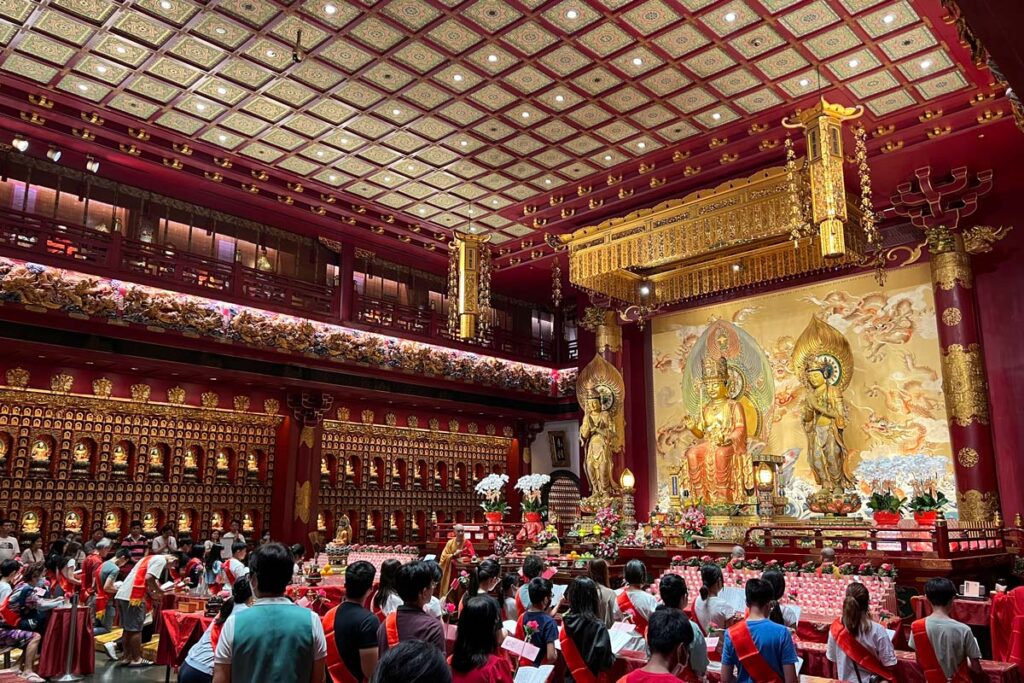
Despite being a more recent Chinatown addition (only completed in 2007) this vast complex has come to serve as the anchor of the neighborhood. It’s a beautiful example of classic Chinese architecture, with richly gilded halls and intricate design elements. One of the focal points is the 15-foot tall Buddha statue that overlooks stately Hundred Dragon Hall.
Most visitors solely pass through the ground floor, but there are many hidden gems to discover on the floors above, too. You’ll find galleries exhibiting both religious relics and secular art pieces. The temple’s namesake tooth, believed to have been recovered from Buddha’s funeral pyre, is also on display on the fourth floor.
Beyond being a must-see attraction for visitors, Buddha Tooth is also an active community gathering place, and you’ll frequently find it bustling with locals and tourists alike. Directions.
Chinatown Street Market
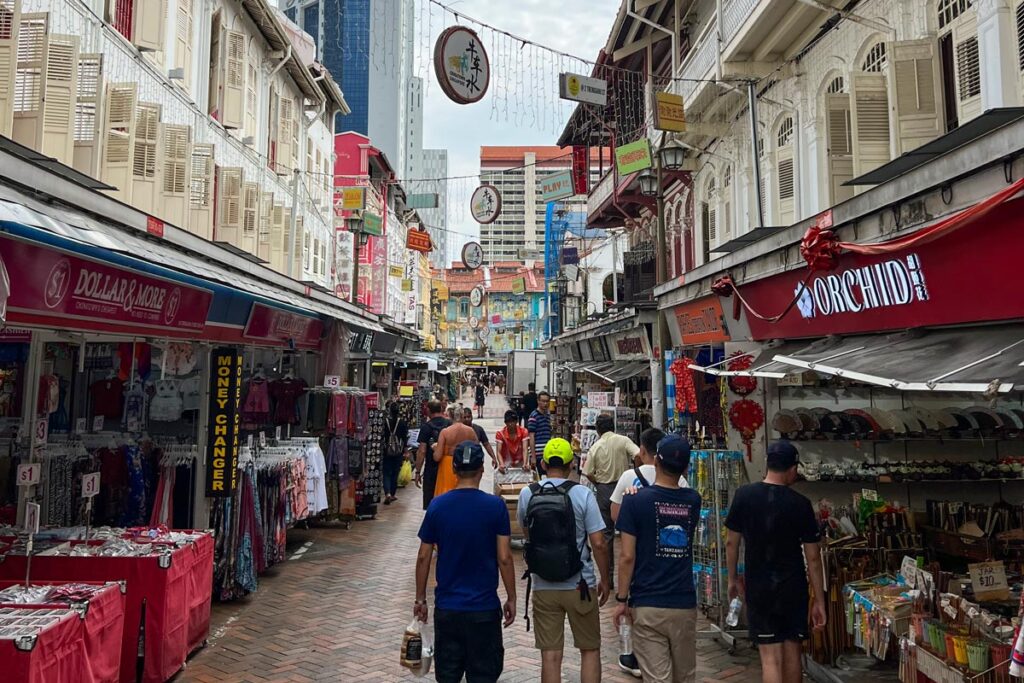
Enjoy getting lost in the Chinatown Street Market, which is a veritable maze of stalls hawking everything from cheap knick-knacks to more quality wares. You’ll inevitably find a unique souvenir here, from brightly-colored scarves and ceramic tea ware, to home goods and even glass-blown Christmas ornaments. Directions.
Get a Custom Suit Made

Singapore is famous for its custom suit industry, and many of the city’s best tailors are located in Chinatown. During your 1-2 hour appointment, tailors will take meticulous measurements and guide you through selecting your preferred fabric and cut. If you’re unsure which style you want, you can also try on sample suits to ensure you get it just right. From there, tailors will make your suit to order and ship it to your home address, all for significantly less than what you’d pay at home.
Regardless of which tailor you choose, we strongly recommend making an appointment in advance — most of the quality places don’t allow walk-ins. For what it’s worth, we visited Edit Suits Co., and my husband was thrilled with the end product. Directions.
Learn the Art of Tea Tasting
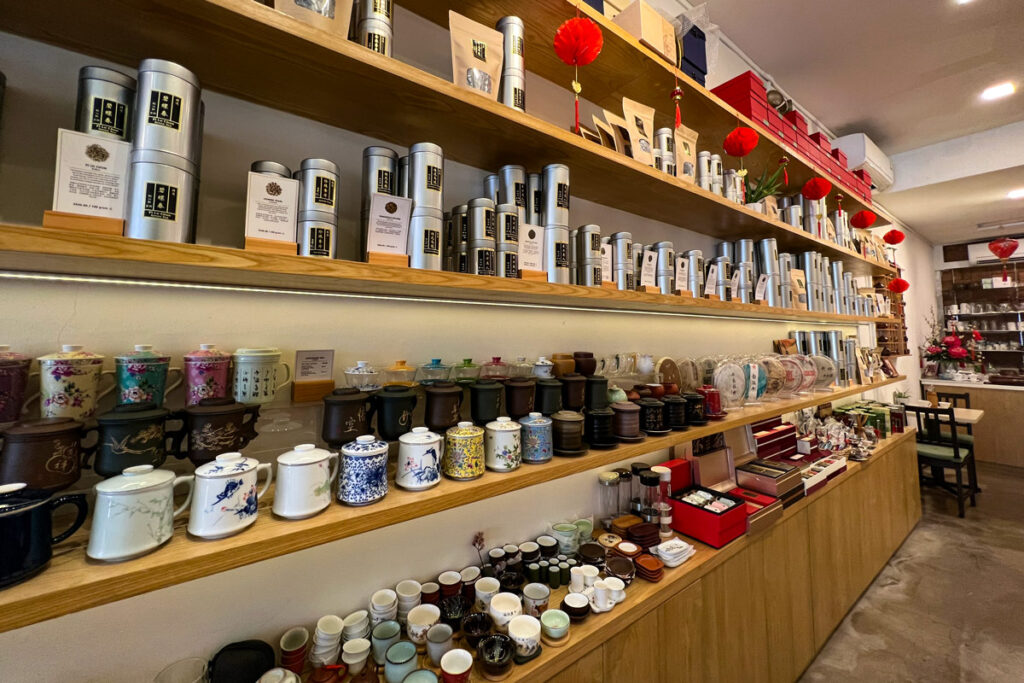
Tea aficionados will enjoy the host of tea shops here, where traditional tea culture remains revered.
One of our favorites is Yixing Xuan, which has been elevating tea tastings since 1989. Visit their comfortable tea house, and you’ll have your choice of over 60 teas, from delicate whites to robust pu-erh. You can either create your own sampling, or sign up for one of their 1-hour workshops, which will guide you through the history, preparation, and art of tasting. The shop also retails highest-grade loose-leaf teas and drink ware, which make great gifts for friends and family back home. Directions.
Another neighborhood institution is Pek Sin Choon, which has been brewing teas and tisanes since 1925. Their storefront retails over 80 different loose-leaf varietals, including oolong, green, white, pu-erh, and herbals. They also sell quality stoneware and ceramic tea sets and accessories. Directions.
Explore More Traditional Temple Architecture
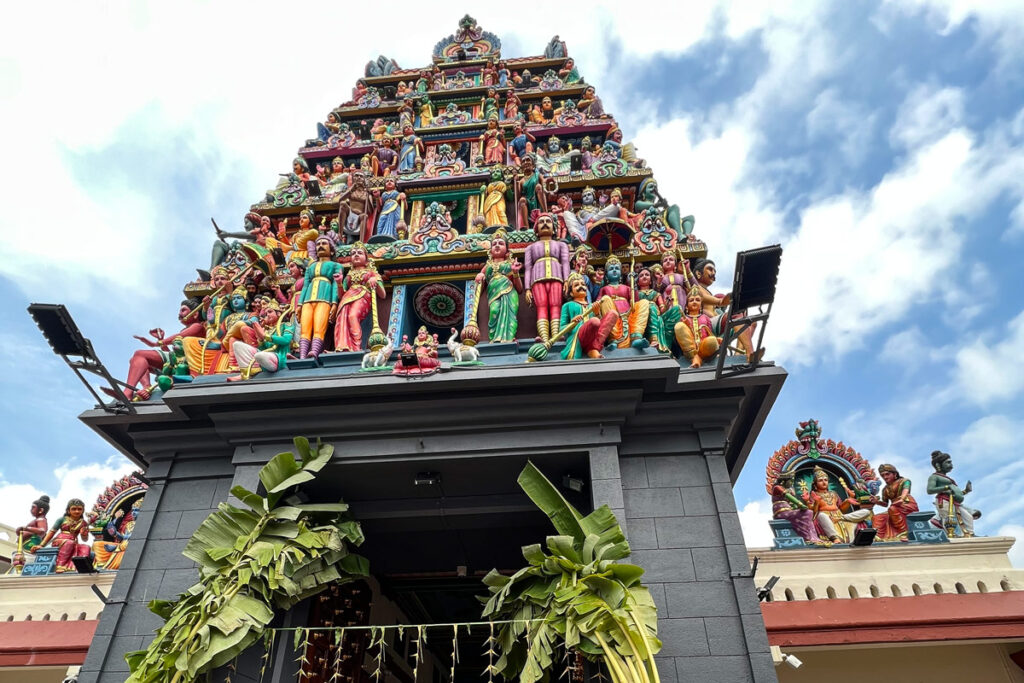
Beyond just Buddha Tooth Relic, Chinatown has many other temples that also reflect the rich cultural and religious heritage of Singapore. You can also visit:
- Thian Hock Keng is Singapore’s oldest Chinese temple, and dates back to 1840. The name translates to “Palace of Heavenly Happiness” and is a gorgeous example of traditional Chinese architecture in the Fujian style. Ornate gilded panels, intricate dragons, and other motifs decorate the complex, which is built around a main courtyard. Directions.
- Sri Mariamman, built in 1827, is Singapore’s oldest Hindu temple. Unquestionably, the biggest highlight is the roof of the structure, which is comprised of six tiers. Each tier is entirely sculpted of brightly-painted deities and other decorative elements, including both humans, animals, and Hindu symbols. The result is a kaleidoscope of colors and detail, that is dizzying in its scale. Directions.
- Masjid Jamae is one of the city’s oldest mosques, constructed just one year before Sri Mariamman. Just like the city it inhabits, the architecture is a unique blend of east and west, combining both Indian, Islamic, and European elements. Visitors are permitted to enter, and will be provided cover-ups at the entrance to ensure respectfulness of community members. Directions.
Dining
Food Halls
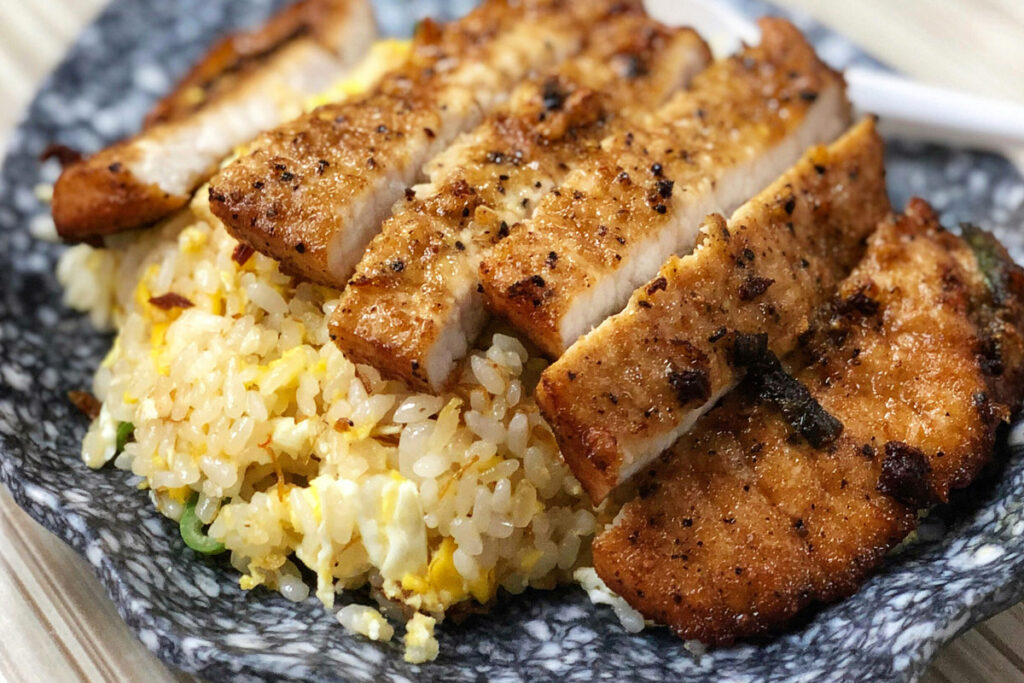
Chinatown’s food halls, including both Chinatown Complex, Amoy Street Food Centre, and Maxwell Food Centre, all offer an array of traditional dishes at the hundreds of stalls between them. Many of the hawker stalls have even made the Michelin Bib Gourmand list for their take on classic comfort foods.
Michelin Bib Gourmand stalls at Chinatown Complex:
- Zhong Guo La Mian Xiao Long Bao (steamed buns)
- Lian He Ben Ji (claypot)
- Ann Chin Handmade Popiah (spring rolls, like lumpia in the Philippines)
- C.M.Y. Satay (skewers)
- The 1950’s Coffee (traditional Singaporean breakfast of kaya toast and coffee)
- Fatty Ox HK Meats (noodles and BBQ meat dishes)
Michelin Bib Gourmand stalls at Amoy Street Food Centre:
- A Noodle Story (innovative takes on traditional noodle bowls)
- Ah Ter Authentic Teochew (fish ball noodle soup)
- Hoo Kee Bak Chang (glutinous rice with duck egg yolk)
- J2 Famous Crispy Curry Puff (flaky pastry with savory filling)
- Yuan Chun Famous Lor Mee (noodles in a rich gravy soup, with choice of toppings)
Michelin Bib Gourmand stalls at Maxwell Food Centre:
- Tian Tian Hainanese Chicken Rice (simple chicken on a bed of rice; Anthony Bourdain raved about this spot)
- Rojak‧Popiah & Cockle (regional salads, spring rolls, and cockles)
- Maxwell Fuzhou Oyster Cakes (crispy fried crust, stuffed with oysters, prawns, and pork)
Restaurants
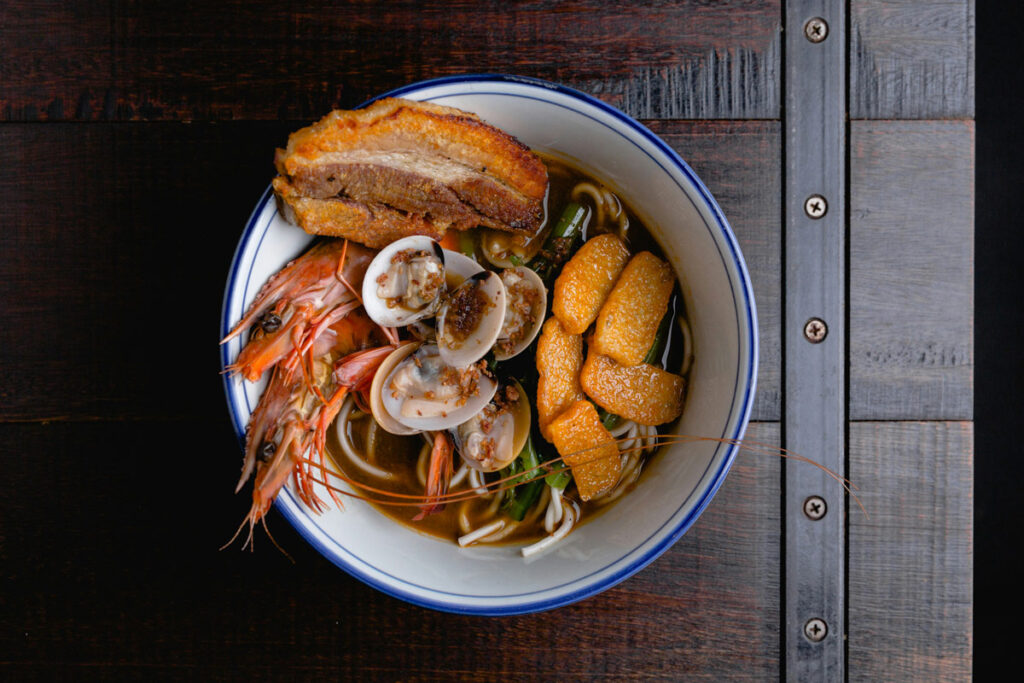
There are cultural eats aplenty among Chinatown’s more established sit-down restaurants, too. The Blue Ginger is an ode to the city’s Peranakan heritage, with dishes that blend classic Chinese elements with flavors of the Malay peninsula. Classic Singaporean staples get an upgrade at Kok Sen, while Restaurant Ibid takes on Asian fusion (both of which have also made the Bib Gourmand list). Or, for a unique take on familiar favorites, Espoir blends modern European with Malayan influences.
For international fare, you’ll find delicious bites at both Merci Marcel (a delightful, casual French bistro) and FOC (trendy Spanish, with an emphasis on Barcelona cuisine).
Michelin aficionados can also head to either Euphoria or Willow (both Michelin 1-stars) or Zen (3 stars) for an elevated dining experience.
Cocktail Bars
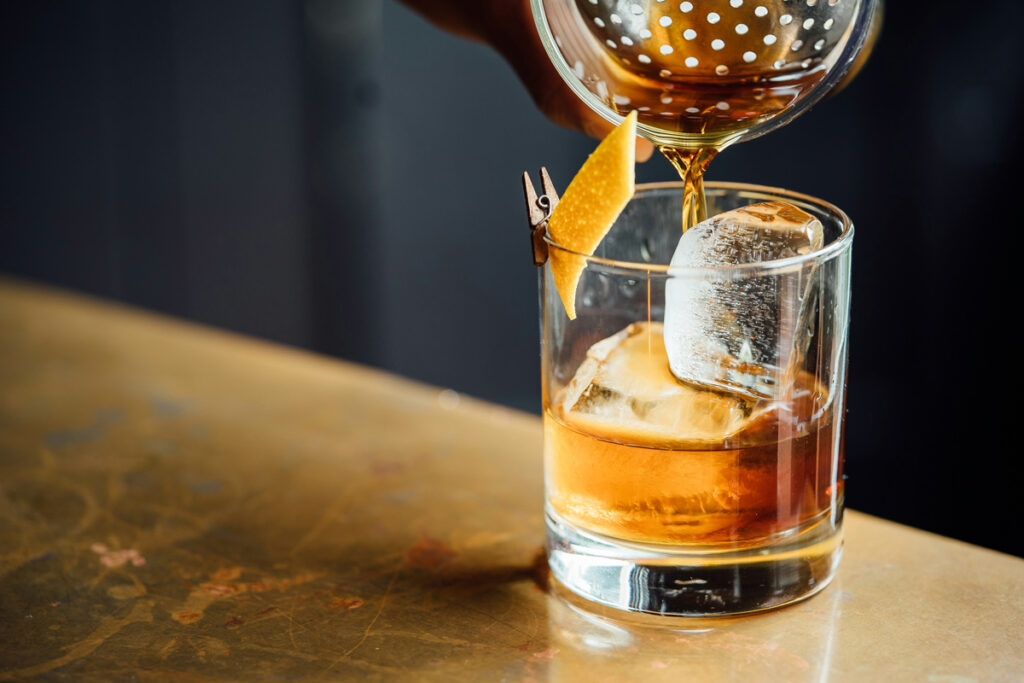
Once you’re ready for a nightcap, you can’t go wrong at either Native or No Sleep Club. Both of these establishments have made the list of Asia’s 50 Best Bars, and for good reason.
Native elevates mixology to an art form, sourcing regional ingredients and botanicals for their craft drinks. While just down the road, No Sleep Club has a rebellious, tongue-in-cheek quality to it. They serve delicious bar bites and dishes alongside sleek cocktails.
Have more time to explore Singapore? Check out our 3 day guide to the best things to do in the Lion City.
